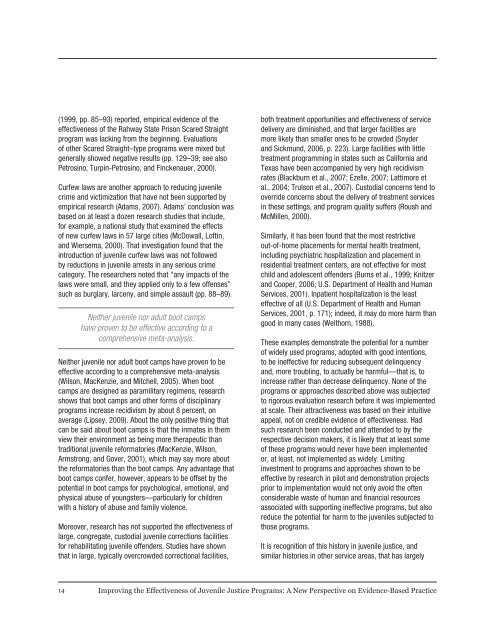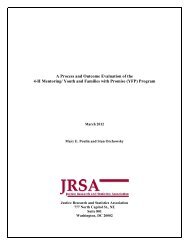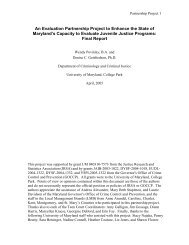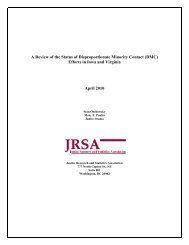Improving the Effectiveness of Juvenile Justice Programs: A New
Improving the Effectiveness of Juvenile Justice Programs: A New
Improving the Effectiveness of Juvenile Justice Programs: A New
You also want an ePaper? Increase the reach of your titles
YUMPU automatically turns print PDFs into web optimized ePapers that Google loves.
(1999, pp. 85–93) reported, empirical evidence <strong>of</strong> <strong>the</strong><br />
effectiveness <strong>of</strong> <strong>the</strong> Rahway State Prison Scared Straight<br />
program was lacking from <strong>the</strong> beginning. Evaluations<br />
<strong>of</strong> o<strong>the</strong>r Scared Straight–type programs were mixed but<br />
generally showed negative results (pp. 129–39; see also<br />
Petrosino, Turpin-Petrosino, and Finckenauer, 2000).<br />
Curfew laws are ano<strong>the</strong>r approach to reducing juvenile<br />
crime and victimization that have not been supported by<br />
empirical research (Adams, 2007). Adams’ conclusion was<br />
based on at least a dozen research studies that include,<br />
for example, a national study that examined <strong>the</strong> effects<br />
<strong>of</strong> new curfew laws in 57 large cities (McDowall, L<strong>of</strong>tin,<br />
and Wiersema, 2000). That investigation found that <strong>the</strong><br />
introduction <strong>of</strong> juvenile curfew laws was not followed<br />
by reductions in juvenile arrests in any serious crime<br />
category. The researchers noted that “any impacts <strong>of</strong> <strong>the</strong><br />
laws were small, and <strong>the</strong>y applied only to a few <strong>of</strong>fenses”<br />
such as burglary, larceny, and simple assault (pp. 88–89).<br />
Nei<strong>the</strong>r juvenile nor adult boot camps<br />
have proven to be effective according to a<br />
comprehensive meta-analysis.<br />
Nei<strong>the</strong>r juvenile nor adult boot camps have proven to be<br />
effective according to a comprehensive meta-analysis<br />
(Wilson, MacKenzie, and Mitchell, 2005). When boot<br />
camps are designed as paramilitary regimens, research<br />
shows that boot camps and o<strong>the</strong>r forms <strong>of</strong> disciplinary<br />
programs increase recidivism by about 8 percent, on<br />
average (Lipsey, 2009). About <strong>the</strong> only positive thing that<br />
can be said about boot camps is that <strong>the</strong> inmates in <strong>the</strong>m<br />
view <strong>the</strong>ir environment as being more <strong>the</strong>rapeutic than<br />
traditional juvenile reformatories (MacKenzie, Wilson,<br />
Armstrong, and Gover, 2001), which may say more about<br />
<strong>the</strong> reformatories than <strong>the</strong> boot camps. Any advantage that<br />
boot camps confer, however, appears to be <strong>of</strong>fset by <strong>the</strong><br />
potential in boot camps for psychological, emotional, and<br />
physical abuse <strong>of</strong> youngsters—particularly for children<br />
with a history <strong>of</strong> abuse and family violence.<br />
Moreover, research has not supported <strong>the</strong> effectiveness <strong>of</strong><br />
large, congregate, custodial juvenile corrections facilities<br />
for rehabilitating juvenile <strong>of</strong>fenders. Studies have shown<br />
that in large, typically overcrowded correctional facilities,<br />
both treatment opportunities and effectiveness <strong>of</strong> service<br />
delivery are diminished, and that larger facilities are<br />
more likely than smaller ones to be crowded (Snyder<br />
and Sickmund, 2006, p. 223). Large facilities with little<br />
treatment programming in states such as California and<br />
Texas have been accompanied by very high recidivism<br />
rates (Blackburn et al., 2007; Ezelle, 2007; Lattimore et<br />
al., 2004; Trulson et al., 2007). Custodial concerns tend to<br />
override concerns about <strong>the</strong> delivery <strong>of</strong> treatment services<br />
in <strong>the</strong>se settings, and program quality suffers (Roush and<br />
McMillen, 2000).<br />
Similarly, it has been found that <strong>the</strong> most restrictive<br />
out-<strong>of</strong>-home placements for mental health treatment,<br />
including psychiatric hospitalization and placement in<br />
residential treatment centers, are not effective for most<br />
child and adolescent <strong>of</strong>fenders (Burns et al., 1999; Knitzer<br />
and Cooper, 2006; U.S. Department <strong>of</strong> Health and Human<br />
Services, 2001). Inpatient hospitalization is <strong>the</strong> least<br />
effective <strong>of</strong> all (U.S. Department <strong>of</strong> Health and Human<br />
Services, 2001, p. 171); indeed, it may do more harm than<br />
good in many cases (Weithorn, 1988).<br />
These examples demonstrate <strong>the</strong> potential for a number<br />
<strong>of</strong> widely used programs, adopted with good intentions,<br />
to be ineffective for reducing subsequent delinquency<br />
and, more troubling, to actually be harmful—that is, to<br />
increase ra<strong>the</strong>r than decrease delinquency. None <strong>of</strong> <strong>the</strong><br />
programs or approaches described above was subjected<br />
to rigorous evaluation research before it was implemented<br />
at scale. Their attractiveness was based on <strong>the</strong>ir intuitive<br />
appeal, not on credible evidence <strong>of</strong> effectiveness. Had<br />
such research been conducted and attended to by <strong>the</strong><br />
respective decision makers, it is likely that at least some<br />
<strong>of</strong> <strong>the</strong>se programs would never have been implemented<br />
or, at least, not implemented as widely. Limiting<br />
investment to programs and approaches shown to be<br />
effective by research in pilot and demonstration projects<br />
prior to implementation would not only avoid <strong>the</strong> <strong>of</strong>ten<br />
considerable waste <strong>of</strong> human and financial resources<br />
associated with supporting ineffective programs, but also<br />
reduce <strong>the</strong> potential for harm to <strong>the</strong> juveniles subjected to<br />
those programs.<br />
It is recognition <strong>of</strong> this history in juvenile justice, and<br />
similar histories in o<strong>the</strong>r service areas, that has largely<br />
14 <strong>Improving</strong> <strong>the</strong> <strong>Effectiveness</strong> <strong>of</strong> <strong>Juvenile</strong> <strong>Justice</strong> <strong>Programs</strong>: A <strong>New</strong> Perspective on Evidence-Based Practice

















